A Century of Immigration,
1820-1924
In the century spanning the years
1820 through 1924, an increasingly steady flow of Jews made their
way to America, culminating in a massive surge of immigrants towards
the beginning of the twentieth century. Impelled by economic hardship,
persecution, and the great social and political upheavals of the
nineteenth century--industrialization, overpopulation,
and urbanization--millions of Europe's Jews left
their towns and villages and embarked on the arduous journey to
the "Golden Land" of America.
In the first half of the nineteenth
century, Jewish immigrants came mostly, though not exclusively,
from Central Europe. In addition to settling in New York, Philadelphia,
and Baltimore, groups of German-speaking Jews made their way to
Cincinnati, Albany, Cleveland, Louisville, Minneapolis, St. Louis,
New Orleans, San Francisco, and dozens of small towns across the
United States. During this period there was an almost hundred-fold
increase in America's Jewish population from some 3,000 in 1820
to as many as 300,000 in 1880.
Between 1881 and 1924, the migration
shifted from Central Europe eastward, with over two-and- one-half
million East European Jews propelled from their native lands by
persecution and the lack of economic opportunity. Most of those
who arrived as part of this huge influx settled in cities where
they clustered in districts close to downtowns, joined the working
class, spoke Yiddish, and built strong networks of cultural, spiritual,
voluntary, and social organizations. This period of immigration
came to an end with the passage of restrictive laws in 1921 and
1924. Jewish emigration from Eastern Europe to the United States
never again reached the levels that it did before 1920.
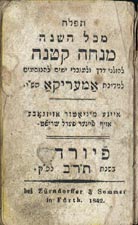
Tefilah
mi-kol ha-shanah: Minhah Ketanah
[Prayers of the Entire Year: Minor Offering].
Fürth: Zurndorffer & Sommer, 1842.
Hebraic Section (40)
|
Prayer Book for Travelers to America
This miniature daily prayer book was printed in Germany
in 1842, "especially for travelers by sea to the nation of
America." It is the first of three editions of this tiny
prayer book published between 1840 and 1860--a period when
Jews from German lands immigrated to this country in the
tens-of-thousands. Between 1840 and 1860 the Jewish population
of this country ballooned from 15,000 to 150,000. Political
unrest and economic hardship were primary motivating factors
for this migration.
|
"Give Me Your Tired, Your Poor . . . "
Emma Lazarus, who had worked with East European immigrants
through her association with the Hebrew Emigrant Aid Society,
composed "The New Colossus" in 1883 as part of a fundraising
campaign for erecting the Statue of Liberty. In 1903, a tablet
with her words--"Give me your tired, your poor, your huddled
masses yearning to breathe free"--was affixed to the statue's
base. These words remain the quintessential expression of
America's vision of itself as a haven for those denied freedom
and opportunity in their native lands. Shown here is a copy
of the sonnet in the author's own hand.

|
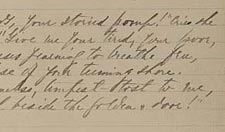
Emma Lazarus (1849-1887)
"The New Colossus"
[titled "Sonnet" in notebook]
1883
Manuscript poem, bound in journal
Courtesy of the American Jewish Historical Society,
New York and Newton Centre, Massachusetts (41)
|
Deed to the Statue of Liberty
This deed, dated July 4, 1884, marks the presentation of
Frederic Auguste Bartholdi's colossal statue, "Statue of
Liberty Enlightening the World" to the people of the United
States from the "people of the Republic of France . . . attesting
to their abiding friendship." In 1886, the Statue of Liberty
was erected on its pedestal at Bedloe's Island in New York
Harbor. At the inauguration ceremony on October 28, President
Grover Cleveland accepted the statue on behalf of the American
people, promising, "we will not forget that Liberty has here
made her home; nor shall her chosen altar be neglected."
|
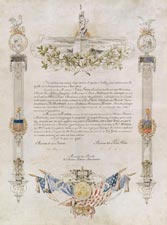
Deed
of Gift for the Statue of Liberty.
Document with watercolor, July 4, 1884.
Enlarged version
Courtesy of the National Archives and Records
Administration, Washington, D.C. (44)
|
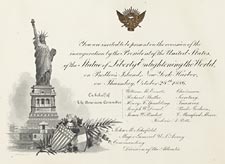
Invitation
to the inauguration of the Statue of Liberty
by the President (Grover
Cleveland), Oct 28, 1886.
Printed invitation engraved with gold seal
and lithograph of statue.
William Maxwell Evarts Papers.
Manuscript Division (45)
|
Long Live the Land of the Free
Patriotic songs in Yiddish expressing the immigrants' love
for America and loyalty to the "Land of the Free," were popular
among the new arrivals. This song opens with: "To express
loyalty with every/fibre of one's being, to/this Land of
Freedom, is the/sacred duty of every Jew." Featured on the
cover of "Leben zol Amerika"[Long Live America] are three
favored icons of American Jewish immigrant sensibility: George
Washington, Abraham Lincoln, and the Statue of Liberty.
|
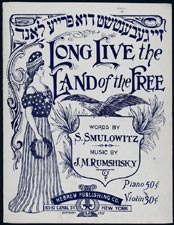
Solomon
Smulewitz (1868-1943)
and J.M. Rumshisky (1879-1956).
"Zei gebensht Du Freie
Land"
[Long Live the Land of the Free].
New York: Hebrew Publishing Company, 1911.
Sheet music cover.
Music Division (50)
|
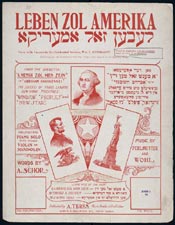
Leo Rosenberg
(1879-1963) and M. Rubinstein.
"Leben Zol Amerika"
[Long Live America].
New York: A. Tores, n.d.
Sheet music cover.
Hebraic Section (51)
|
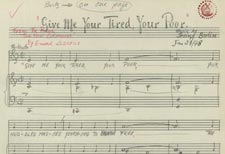
Irving Berlin (1888-1989)
and Emma Lazarus (1849-1887)
"Give Me Your Tired, Your
Poor," from Miss Liberty, 1949.
Piano vocal score.
Irving Berlin Collection.
Music Division (48)
|
Irving Berlin's Miss Liberty
Set in 1885, Irving Berlin's Broadway musical Miss Liberty centers
on the dedication ceremonies of the Statue of Liberty and
the hero's search for the model that posed for Bertholdi's
statue. Berlin, himself an immigrant from Russia, set music
to Emma Lazarus's iconic poem, "Give Me Your Tired, Your
Poor." It is the only song in the Irving Berlin canon for
which he used someone else's words.
|
Next Year in America!
Under the Imperial Russian coat of arms, traditionally dressed
Russian Jews, packs in hand, line Europe's shore as they
gaze across the ocean. Waiting for them under an American
eagle holding a banner with the legend "Shelter me in the
shadow of your wings" (Psalms 17:8), are their Americanized
relatives, whose outstretched arms simultaneously beckon
and welcome them to their new home.
|
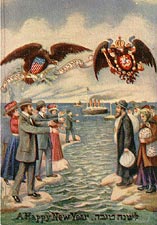
A
Happy New Year.
Hebrew Publishing Company, between 1900 and 1920.
Offset color lithograph postcard.
Alfred and Elizabeth Bendiner Collection.
Prints and Photographs Division (52)
|
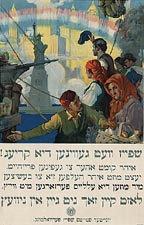
Charles
Chambers (1883-1941).
Food Will Win the War--You
Came Here Seeking
Freedom, Now You Must Help Preserve It.
. . .
New York: Rusling Wood, Litho., 1917.
Color lithograph poster.
Prints and Photographs Division (53)
|
Food Will Win the War!
This World War I poster, published by the United States
Food Administration, appeals in Yiddish to the patriotic
spirit and gratitude of the new arrivals to America. Its
message reads, "Food Will Win the War! You came here seeking
freedom, now you must help to preserve it. We must provide
the Allies with wheat. Let Nothing Go To Waste!" Versions
of this poster were issued in English and Italian as well.
|
Lady America Opens the Gates
On this journal cover, published by the Hebrew Immigrant
Aid Society, Lady Liberty, wearing a cap bearing the legend "America" in
Yiddish, holds a key in one hand and opens a gate to waiting
immigrants with the other. Two verses from the Hebrew scriptures
flank the open gate. On the right, the verse reads: "Open
the gates of righteousness for me" (Psalms 118:19) and on
the left, "Open the gates and let a righteous nation enter" (Isaiah
26:2). |
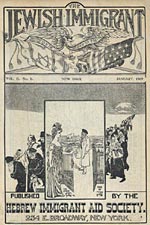
The Jewish Immigrant.
Vol. 2, no. 1. (January 1909).
New York: Hebrew Immigrant Aid Society, 1909
Hebraic Section (54)
|
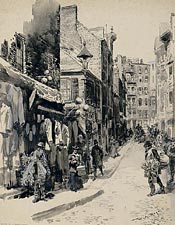
William Allen Rogers
(1854-1931).
The Jewish Quarter, Boston.
Published in Harpers, 1899.
Graphite drawing with wash.
Prints and Photographs Division (56)
|
Boston's Jewish Quarter
This drawing by William Allen Rogers depicts the shops,
street peddlers, and bustling street life of Boston's Jewish
quarter at the turn of the twentieth century. The drawing
illustrated an article by Sylvester Baxter entitled "Boston
at Century's End," which appeared in Harper's Magazine.
|
Waiting for the "Forwards"
This photograph of newsboys Waiting for the "Forwards," was
taken by Lewis Hine at 1:15 a.m. on the steps of the building
where the Jewish daily the Forward was produced
on New York's Lower East Side. According to Hine, the group
included a number of boys as young as ten years-old. The
newsboy in the first row is holding copies of Wahrheit [Truth],
a Yiddish daily newspaper that stressed Jewish national aspirations.

|
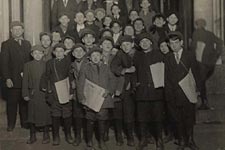
Lewis Hine (1874-1940)
Waiting for the "Forwards" -
Jewish paper at 1 A.M.
New York, March 1913
Gelatin silver print from photographic album
Prints and Photographs Division (58)
|
The Triangle Shirtwaist Company Fire
Jewish women made up the majority of workers in the garment
industry, especially in the dress and shirtwaist trade. Poor
working conditions, low wages, and frequent layoffs propelled
many into the International Ladies' Garment Workers Union.
On March 25, 1911, 146 garment workers lost their lives in
the Triangle Shirtwaist factory fire in New York's Greenwich
Village. Many were trapped inside because the escape exits
had been locked to keep the girls in and the union organizers
out. The fire was one of New York's worst industrial accidents
and was covered by newspapers across the nation, including
the Oklahoma State Capital, which is displayed here.
|
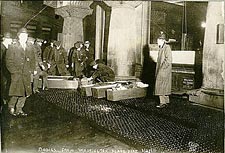
Bain News
Service.
Bodies from Washington Place Fire,
March 25, 1911.
Gelatin silver print.
George Grantham Bain Collection.
Prints and Photographs Division (59)
|
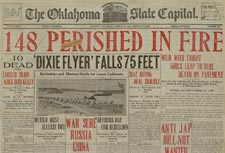
"148
Perished in Fire,"
Oklahoma State Capital (March 26, 1911).
Detail
Newspaper front page.
Serial and Government Publications Division (61)
|
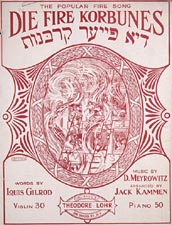
David Meyrowitz
(1867-1943) and
Louis Gilrod (1879-1930).
Die Fire Korbunes
[The Fire Victims].
New York: Theodore Lohr Co., 1911.
Sheet music cover.
Irene Heskes Collection.
Music Division (62)
|
The Fire Victims
Yiddish American popular song was rooted in Eastern European
Jewish minstrelsy, which had long addressed current social,
economic, and political themes. "Die Fire Korbunes" [The
Fire Victims] is an elegy to the 146 victims, mostly young
Jewish and Italian immigrant women, who perished in the March
25, 1911 fire at the Triangle Shirtwaist Company factory,
a New York City garment sweatshop
|
The Triangle Waist Company
A salivating demonic figure, labeled the Triangle Waist
Company, draws a long line of women into his factory. There
they are consumed by the fire's raging inferno and drift
upward towards heaven in the smoky aftermath of the fire.
Public sympathy and outrage over the tragedy led to the establishment
of a Factory Investigating Commission that was instrumental
in drafting new legislation that mandated improved working
conditions.
|
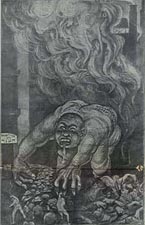
Lola [Leon Israel].
Der Groyser Kundes
[The Big Stick].
Vol. 3, no. 14 (April 7, 1911).
New York: Jewish Publishing
and Advertising Co., 1911.
Hebraic Section (63)
|
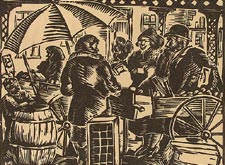
Albert Potter (1903-1937)
Eastside New York,
between 1931 and 1935
Woodcut print
Ben and Beatrice Goldstein
Foundation Collection
Prints and Photographs Division (67)
|
New York's Lower East Side
Shown here is a street scene from New York's Lower East
Side, which was the center of Jewish immigrant life in the
early twentieth century. Congested and bursting with activity
and commerce, the crowded streets of the Lower East Side
accommodated both a bustling pushcart trade as well as various
retail occupations, such as kosher butcher shops, bakeries,
and restaurants, which catered to Jewish tastes. The artist,
Albert Potter, was born in Russia and grew up in Providence,
Rhode Island, where he attended the Rhode Island School of
Design.
|
Becoming American
A variety of publications were issued to help Americanize
the new immigrants. Bi-lingual Yiddish-English versions of
the Constitution and the Declaration of Independence were
published for the new Americans, as were phrase books in
Yiddish, English, and Ladino (Judeo-Spanish)--all intended
to help the immigrants function in their new environment.
Alexander Harkavy's English-Yiddish letter writing guides
were especially popular, selling thousands of copies in multiple
editions. Shown here is Harkavy's American Letter Writer,
opened to a sample letter "From a Lady to a Gentleman, Complaining
of Faithlossness (sic)." |
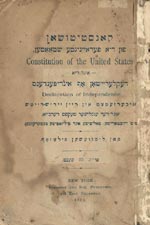
Konstitushon
fun di Fereynigte Shtaten
und Deklereyshon of Indipendens
[Constitution of the United States
and the Declaration of Independence].
New York: Sarasohn and Son, Pub., 1892.
Hebraic Section (72)
|
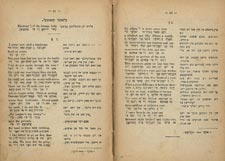
Hirsh Vand (b.1847).
Der Englisher Tolmatsh.
Warsaw: Gebruder Shuldberg, 1891.
Hebraic Section (73)
|
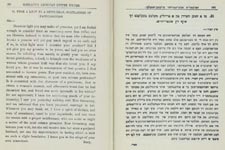
Alexander
Harkavy (1863-1939).
Harkavy's Amerikanisher Briefenshteler
[Harkavy's American Letter Writer].
New York: Hebrew Publishing Co., 1902.
Hebraic Section (74)
|
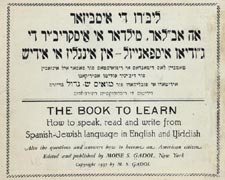
Moise S.
Gadol (1874-1941).
Libro de Embezar, The
Book to Learn How to Speak, Read and Write from Spanish-Jewish
Language in English and Yiddish.
New York: 1937.
Hebraic Section (75A)
|
Many Peoples, One Language
These posters announce two initiatives, separated by about
two decades but both drawing on a multi-generational approach
to teach immigrants the English language. The 1917 poster
to the left includes a call to "Invite your parents, brothers
and sisters to attend free public school evenings," to
encourage the immigrant parents of children in public schools
to attend night classes and learn English. The WPA Adult
Education program of the 1930s and 40s teamed with New
York City's Board of Education to sponsor free English
classes to help parents "learn to speak, read, and write
the language of your children." In addition, naturalization
classes and "special classes for educated foreign born" are
advertised on this Yiddish and English poster.
|
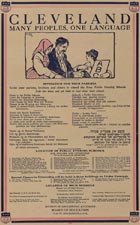
J.H. Donahey (1875-1949)
Cleveland, Many Peoples,
One language
["Invite your parents, brothers and sisters
to attend free public evening schools"]
Color poster
1917
Courtesy of the HUC Skirball Cultural Center
Museum Collection, Los Angeles (77)
|
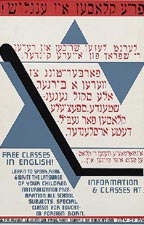
Free classes in English!:
Learn to Speak,
Read & Write the Language of our Children.
New York City: Federal Art Project,
1936-1941
Silkscreen poster
Prints and Photographs Division (84)
|
A Boychik Up-to-date
The subject of this sheet music's title page is a garishly
dressed boychick, or dandy, who has become so Americanized
that his Jewishness is not outwardly apparent. The song is
critical of this boychik and, through him, the American milieu
that created him. |
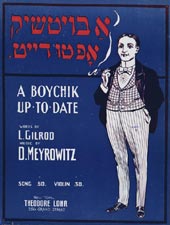
David Meyrowitz (1867-1943) and
Louis Gilrod (1879-1930)
A Boychik Up-to-Date [An Up-to-Date
Dandy].
New York: Theodore Lohr, n.d.
Sheet music cover
Hebraic Section (78)
|
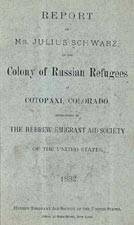
Julius Schwarz.
Report of Mr. Julius
Schwarz on the Colony of Russian Refugees at Cotopaxi,
Colorado . . . 1882.
New York: Hebrew Emigrant Aid Society of the United States, [1882].
General Collections (81)
|
A Russian Jewish Colony in Cotopaxi, Colorado
In his report to the board of the Hebrew Emigrant Aid Society,
which sponsored the colonization activities of a small group
of Russian Jewish settlers in Cotopaxi, Colorado, Julius
Schwarz wrote: "It is with much satisfaction and justifiable
pride that I pronounce the agricultural colony of the Rocky
Mountains a full and complete success and the question whether
Jews are fit to be farmers, solved and answered in the affirmative."
|
A Wimpel from Colorado
Beginning in southern Germany in the seventeenth century,
the custom developed of transforming the linen swaddling
cloth used to wrap the eight-day-old baby boy at his circumcision
ceremony into a Torah binder. Called a "wimpel," from the
German word for binding, the cloth was cut into strips and
sewn together to form a long band which was embroidered or
painted, usually by the mother or grandmother, with the child's
name, birthdate, and the prayer recited at the circumcision
ceremony that the child be blessed to grow to study the Torah,
to be married, and to do good deeds. The folk art tradition
made its way west with German immigrants in the second half
of the nineteenth century as seen in this example from Trinidad,
Colorado.
|
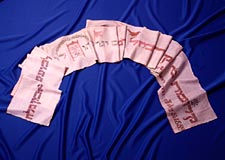
Rabbi Freudenthal. Torah
Binder (wimpel).
Trinidad, Colorado, July 1889 (made in honor of Gilbert Sanders birth).
Paint on linen, with silk thread edging.
Courtesy of the HUC Skirball Cultural Center Museum Collection, Los Angeles
(81A)
|
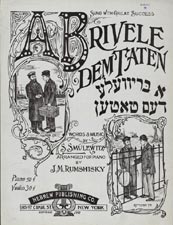
Solomon Smulewitz (1868-1943)
and J.M. Rumshisky (1879-1956).
A Brievele dem Taten
[A
little letter to my father].
New York: Hebrew Publishing Co., 1911.
Sheet music cover.
Hebraic Section (82)
|
A Little Letter to Father
Pictured on this sheet music cover are two scenes: a father
and son parting in the Old World, and the same pair meeting
at Ellis Island. Solomon Smulewitz's lyrics recount a familiar
tale of woe: "Mother has died in loneliness and poverty.
Write a letter to father and send money for him to come to
America. Alas, father is too ill to be admitted here. He
is permitted to see his son at the gate of Ellis Island,
and then will be sent back to Europe."
|
What Every Woman Should Know about Citizenship
The Immigration Assistance Section of the National Council
of Jewish Women issued this citizenship guide for women in
both English and Yiddish. Founded in 1893, the Council focused
on helping unmarried women immigrants learn English, secure
citizenship, and find employment.
|
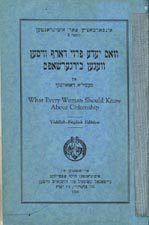
Cecilia Razovsky (1891-1968).
Vos Yede Froy Darf Visen
Vegen Birgershaft, What Every Woman Should Know about Citizenship.
New York: Department of Immigrant Aid,
National Council of Jewish Women, 1926.
Hebraic Section (86)
|
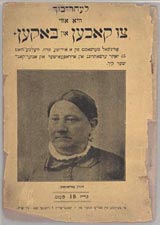
Hinde Amchanitzki.
Lehr-bukh vi azoy tsu kokhen un baken
[Textbook on How to Cook and Bake].
Page 2 - Page
3
New York: ca. 1901.
Hebraic Section (88)
|
First Yiddish American Cookbook
Written in Yiddish, the language understood by the majority
of newly arriving Jewish immigrants, this cookbook served
as an introduction to American as well as traditional Jewish
cuisine. The recipes, which are based on Hinde Amchanitzki's
forty-five years of experience in European and American kitchens,
include traditional Jewish dishes as well as American fare.
In her introduction, the author promises that using her recipes
will prevent stomach aches and other food-related maladies
in children. This first American Yiddish cookbook pictures
the author on the cover. Displayed on the accompanying page
are recipes in Yiddish for two desserts, "Snowballs" and "Rhubarb
Pie."
|
Awake and Sing!
The Federal Theater Project produced a Yiddish language
version of Clifford Odets's groundbreaking depiction of a
Jewish family living in the Bronx during the Depression years.
Burdened with financial difficulties, the family struggles
to survive. In the play's climax, the socialist grandfather
delivers the central message of the play, calling his family
to action and urging them to "Go out and fight so life shouldn't
be printed on dollar bills." The title is from Isaiah (26:19): "Awake
and sing, ye that dwell in the dust."
|
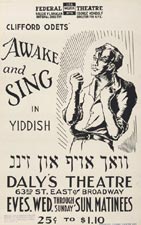
Clifford Odets (1906-1963).
Awake and Sing.
Federal Theatre, New York City.
Offset lithograph poster.
Federal Theatre Project Collection.
Music Division (92)
|
This image is not
available online.
Philip Roth (b. 1933).
Typed manuscript with emendations,
published as Patrimony: A True Story (1996).
Page 2
Philip Roth Papers.
Manuscript Division (55) |
Europe Stopped with Him
In Patrimony, A True Story, Philip Roth's award-winning
memoir of his father's last years, Roth summed up his father's
life's work--as well as the work of a whole generation of
Jews--in the following moving passage: "I drive him around
or I sit with him or I eat with him and I am thinking that
the real work, the invisible, huge job that he did all his
life, that his whole generation of Jews did, was making themselves
American. Europe stopped with him." Displayed here are two
pages from a typed draft of the manuscript, with emendations
in the author's hand.
|
Houdini: from Budapest to Appleton
The great magician and escape artist, Harry Houdini (originally
Eric Weiss), was born in Budapest, Hungary, and was taken
to the U. S. when his father became the religious leader
of a Jewish congregation in Appleton, Wisconsin. Displayed
here is the inside cover of a Bible belonging to his father,
Rabbi Samuel Weiss. The two
photographs displayed here show Houdini with his "two sweethearts,"--wife
Beatrice and mother Cecilia Steiner Weiss--and, in the other,
planting a kiss on his mother's cheek.
|
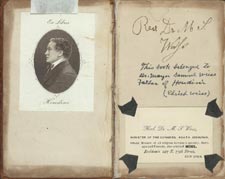
Fly-leaf and First Page
of the Bible of Rabbi Samuel Weiss (1829-1892), father of
Harry Houdini (1874-1926)
Die Bible oder Die ganze Heilige Schrift des Alten und
Neuen Testaments.
New York: Amerikanische Bibel-Gesellschaft, 1892
McManus-Young Collection
Rare Book and Special
Collections Division (96)
|
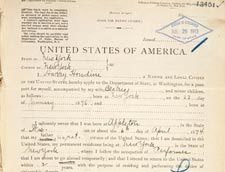
Harry Houdini (1874-1926).
Passport application, no.13451,
July 25, 1913.
Enlarged version
Courtesy of the National Archives and Records
Administration, Washington, D.C. (95)
|
|
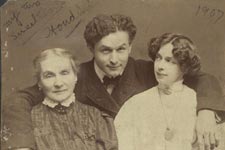
"My Two Sweethearts"
[Houdini with his wife and mother]
Gelatin silver print, ca. 1907
McManus-Young Collection
Rare Book and Special
Collections Division (97A)
|
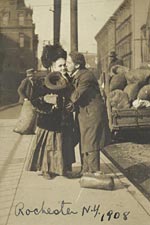
Harry Houdini with his mother
Cecilia Steiner Weiss (d. 1913),
Rochester, New York
Gelatin silver print, ca. 1907
McManus-Young Collection
Rare Book and Special
Collections Division (97)
|
Albert Einstein: from Berlin to Princeton
In 1933, after Adolf Hitler came to power, Albert Einstein
renounced his German citizenship and immigrated to the United
States, where he accepted an appointment as Professor of
Theoretical Physics at Princeton. In 1936, he completed a "Declaration
of Intention" form to become an American citizen, and, in
1940, he received his certificate of American citizenship
from federal Judge Phillip Forman in a ceremony held in Trenton,
New Jersey.

|
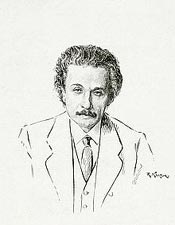
Robert Kastor.
Albert Einstein,
January 21, 1922.
Pen and ink on paper.
Prints and Photographs Division (98)
|
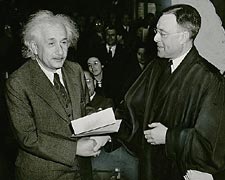
Al Aumuller.
America Gains a Famous Citizen (Albert Einstein),
October 1, 1940.
Gelatin silver print.
New York World-Telegram & Sun Collection.
Prints and Photographs Division (100)
|
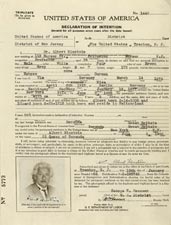
Albert Einstein (1879-1955).
"Declaration of Intention" to become a U.S. citizen, January 15, 1936.
Typescript document and passport photograph.
Courtesy of National Archives and Records Administration Northeast Region,
New York (99) |
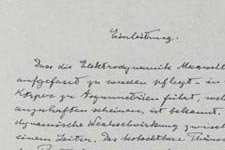
Albert Einstein.
"Zur Elektrodynamik bewegter Korper,"
November 1943.
Holograph essay.
Manuscript Division (101)
|
Einstein's Theory of Relativity
Displayed here is the first page of a holograph copy of "Zur
Elektrodynamik bewegter Korper," which Einstein described
as his first paper concerning the theory of relativity. He
had discarded the original manuscript after it had been published
in Annalen der Physic in 1905. In November 1943,
Einstein rewrote this paper so that it might be presented
to the Library of Congress to help promote the sale of U.S.
War Bonds.
|
Hannah Arendt: from Berlin to Paris to New
York
Author, educator, and political philosopher Hannah Arendt
was born into a German Jewish family in Königsberg,
now Russian "Kaliningrad." After being arrested in 1933,
Arendt fled her homeland, moving from Prague to Geneva then
to Paris, and finally to the United States in 1941. In 1946,
she wrote that she understood that "the infinitely complex
red-tape existence of stateless persons" inhibits freedom
of movement. This denial of the right of citizenship led
Arendt on an exploration of the origins of totalitarianism
that would dominate her intellectual life.
In 1949 Arendt used this well-worn affidavit of identity "in
lieu of a passport, which I, a stateless person, cannot obtain
at present." Also seen here is Arendt's draft of the introduction
to the third edition of Origins Of Totalitarianism,
her most famous book. |
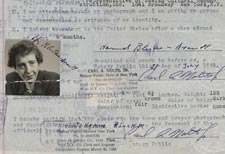
Hannah Arendt
(1906-1975).
Affidavit of Identity in
Lieu of Passport,
January 18, 1949.
Page 2
Typescript with stamps, emendations, and photo.
Hannah Arendt Papers.
Manuscript Division (103)
|
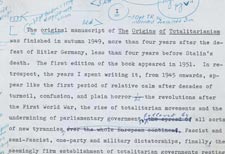
Hannah Arendt
.
"Introduction to the Third Edition"
[Corrected draft of The Origins of Totalitarianism],
1966.
Typescript with author's alterations.
Hannah Arendt Papers.
Manuscript Division (104)
|
|








































